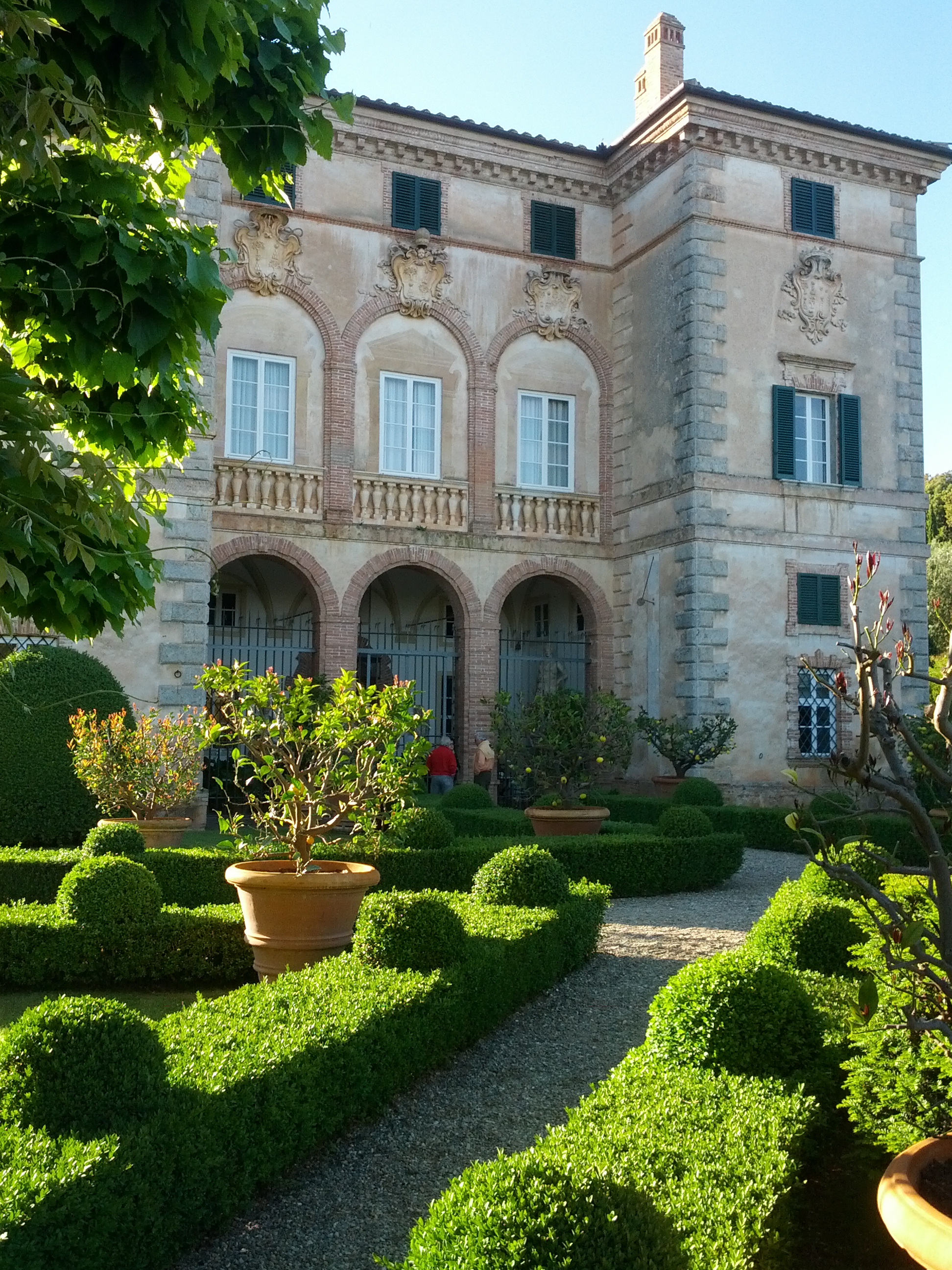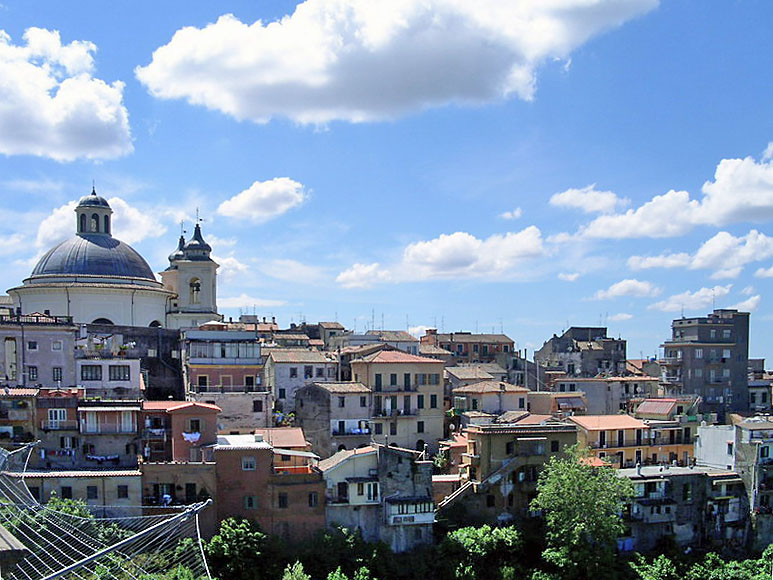|
Villa Cetinale, Siena
Villa Cetinale is a 17th-century Baroque villa and Italian garden in Tuscany. The property is located in the hamlet of Cetinale near Sovicille, about west of Siena, in Tuscany, Italy. The property is best known for the expansive gardens, arrayed in classic symmetry, as well as for its woodland gardens. History 17th century The residence was originally a modest building surrounded by farm dwellings, owned by Fabio Chigi (1599-1667). Chigi employed Benedetto Giovannelli, a local architect, to design the plans for a new villa, whose construction occurred between 1651 and 1655. After Fabio Chigi became Pope Alexander VII, in 1655, work came to a halt. In 1676, the villa and lands were inherited by the Pope's nephew, Cardinal Flavio Chigi (1631-1693), Prince of Farnese, Duke of Ariccia and Prince of the Holy Roman Empire. Cardinal Chigi employed the architect Carlo Fontana in 1680 to redesign the villa, originally called Villa Chigi, and plan the gardens. Fontana was a forme ... [...More Info...] [...Related Items...] OR: [Wikipedia] [Google] [Baidu] |
Villa Cetinale, Veduta
A villa is a type of house that was originally an ancient Roman upper class country house. Since its origins in the Roman villa, the idea and function of a villa have evolved considerably. After the fall of the Roman Republic, villas became small farming compounds, which were increasingly fortified in Late Antiquity, sometimes transferred to the Church for reuse as a monastery. Then they gradually re-evolved through the Middle Ages into elegant upper-class country homes. In the Early Modern period, any comfortable detached house with a garden near a city or town was likely to be described as a villa; most survivals have now been engulfed by suburbia. In modern parlance, "villa" can refer to various types and sizes of residences, ranging from the suburban semi-detached double villa to, in some countries, especially around the Mediterranean, residences of above average size in the countryside. Roman Roman villas included: * the ''villa urbana'', a suburban or country seat ... [...More Info...] [...Related Items...] OR: [Wikipedia] [Google] [Baidu] |
Ariccia
Ariccia (Latin: ''Aricia'') is a town and ''comune'' in the Metropolitan City of Rome, central Italy, southeast of Rome. It is in the Alban Hills of the Lazio (Latium) region and could be considered an extension of Rome's southeastern suburbs. One of the Castelli Romani towns, Ariccia is located in the regional park known as the "Parco Regionale dei Castelli Romani". Overview Ariccia is the center of a region that was extremely important in Roman and pre-Roman mythology and religion because of its association with the goddess Diana and the god Virbius. Legend also recalls that it served as a temporary burial place of the Greek hero Orestes. Ariccia was one of the oldest cities of ancient Latium, and as the leader of the Latin League was a serious contender against Rome during the early days of the Roman Republic. In modern times, Ariccia has become famous for its porchetta, pork that is slowly roasted with herbs and wild fennel, and it has been known since historical times for ... [...More Info...] [...Related Items...] OR: [Wikipedia] [Google] [Baidu] |
Topiary
Topiary is the horticultural practice of training perennial plants by clipping the foliage and twigs of trees, shrubs and subshrubs to develop and maintain clearly defined shapes, whether geometric or fanciful. The term also refers to plants which have been shaped in this way. As an art form it is a type of living sculpture. The word derives from the Latin word for an ornamental landscape gardener, ''topiarius'', a creator of ''topia'' or "places", a Greek word that Romans also applied to fictive indoor landscapes executed in fresco. The plants used in topiary are evergreen, mostly woody, have small leaves or needles, produce dense foliage, and have compact and/or columnar (e.g., fastigiate) growth habits. Common species chosen for topiary include cultivars of European box (''Buxus sempervirens''), arborvitae (''Thuja'' species), bay laurel (''Laurus nobilis''), holly (''Ilex'' species), myrtle (''Eugenia'' or '' Myrtus'' species), yew (''Taxus'' species), and privet (''Ligu ... [...More Info...] [...Related Items...] OR: [Wikipedia] [Google] [Baidu] |
Giuseppe Mazzuoli (1644-1725)
Giuseppe Mazzuoli may refer to: * Giuseppe Mazzuoli (c. 1536 – 1589), Renaissance painter known as ''il Bastaruolo'' * Giuseppe Mazzuoli (1644–1725) Giuseppe Mazzuoli (1644 in Volterra – 1725 in Rome) was an Italian sculptor working in Rome in the Bernini-derived Baroque style. He produced many highly accomplished sculptures of up to monumental scale but was never a leading figure in the R ..., sculptor of Rome * Giuseppe Maria Mazzuoli, an italian sculptor and stucco artist {{DEFAULTSORT:Mazzuoli, Giuseppe ... [...More Info...] [...Related Items...] OR: [Wikipedia] [Google] [Baidu] |
Lemon
The lemon (''Citrus limon'') is a species of small evergreen trees in the flowering plant family Rutaceae, native to Asia, primarily Northeast India (Assam), Northern Myanmar or China. The tree's ellipsoidal yellow fruit is used for culinary and non-culinary purposes throughout the world, primarily for its juice, which has both culinary and cleaning uses. The pulp and rind are also used in cooking and baking. The juice of the lemon is about 5% to 6% citric acid, with a pH of around 2.2, giving it a sour taste. The distinctive sour taste of lemon juice makes it a key ingredient in drinks and foods such as lemonade and lemon meringue pie. History The origin of the lemon is unknown, though lemons are thought to have first grown in Assam (a region in northeast India), northern Myanmar or China. A genomic study of the lemon indicated it was a hybrid between bitter orange (sour orange) and citron. Lemons are supposed to have entered Europe near southern Italy no later tha ... [...More Info...] [...Related Items...] OR: [Wikipedia] [Google] [Baidu] |
Hermitage (religious Retreat)
A hermitage most authentically refers to a place where a hermit lives in seclusion from the world, or a building or settlement where a person or a group of people lived religiously, in seclusion. Particularly as a name or part of the name of properties its meaning is often imprecise, harking to a distant period of local history, components of the building material, or recalling any former sanctuary or holy place. Secondary churches or establishments run from a monastery were often called "hermitages". In the 18th century, some owners of English country houses adorned their gardens with a "hermitage", sometimes a Gothic ruin, but sometimes, as at Painshill Park, a romantic hut which a "hermit" was recruited to occupy. The so-called Ermita de San Pelayo y San Isidoro is the ruins of a Romanesque church of Ávila, Spain that ended up several hundred miles away, to feature in the Buen Retiro Park in Madrid. Western Christian tradition A hermitage is any type of domestic dwelli ... [...More Info...] [...Related Items...] OR: [Wikipedia] [Google] [Baidu] |
Hercules
Hercules (, ) is the Roman equivalent of the Greek divine hero Heracles, son of Jupiter and the mortal Alcmena. In classical mythology, Hercules is famous for his strength and for his numerous far-ranging adventures. The Romans adapted the Greek hero's iconography and myths for their literature and art under the name ''Hercules''. In later Western art and literature and in popular culture, ''Hercules'' is more commonly used than ''Heracles'' as the name of the hero. Hercules is a multifaceted figure with contradictory characteristics, which enabled later artists and writers to pick and choose how to represent him. This article provides an introduction to representations of Hercules in the later tradition. Mythology Birth and early life In Roman mythology, although Hercules was seen as the champion of the weak and a great protector, his personal problems started at birth. Juno sent two witches to prevent the birth, but they were tricked by one of Alcmene's servants and sent ... [...More Info...] [...Related Items...] OR: [Wikipedia] [Google] [Baidu] |
Giardino All'italiana
The Italian garden (or giardino all'italiana () is best known for a number of large Italian Renaissance gardens which have survived in something like their original form. In the history of gardening, during the Renaissance, Italy had the most advanced and admired gardens in Europe, which greatly influenced other countries, especially the French formal garden and Dutch gardens and, mostly through these, gardens in Britain. The gardens were formally laid out, but probably in a somewhat more relaxed fashion than the later French style, aiming to extend or project the regularity of the architecture of the house into nature. From the late 18th century many grand Italian gardens were remade in a version of the English landscape garden style. History and influence The Italian garden was influenced by Roman gardens and Italian Renaissance gardens. The principles of the French garden are based on those of the Italian garden, but André le Nôtre ultimately eclipsed it in scale a ... [...More Info...] [...Related Items...] OR: [Wikipedia] [Google] [Baidu] |
Villa Cetinale 06
A villa is a type of house that was originally an ancient Roman upper class country house. Since its origins in the Roman villa, the idea and function of a villa have evolved considerably. After the fall of the Roman Republic, villas became small farming compounds, which were increasingly fortified in Late Antiquity, sometimes transferred to the Church for reuse as a monastery. Then they gradually re-evolved through the Middle Ages into elegant upper-class country homes. In the Early Modern period, any comfortable detached house with a garden near a city or town was likely to be described as a villa; most survivals have now been engulfed by suburbia. In modern parlance, "villa" can refer to various types and sizes of residences, ranging from the suburban semi-detached double villa to, in some countries, especially around the Mediterranean, residences of above average size in the countryside. Roman Roman villas included: * the ''villa urbana'', a suburban or country seat ... [...More Info...] [...Related Items...] OR: [Wikipedia] [Google] [Baidu] |
Harold Acton
Sir Harold Mario Mitchell Acton (5 July 1904 – 27 February 1994) was a British writer, scholar, and aesthete who was a prominent member of the Bright Young Things. He wrote fiction, biography, history and autobiography. During his stay in China, he studied the Chinese language, traditional drama, and poetry, some of which he translated. He was born near Florence, Italy, to a prominent Anglo-Italian family. At Eton College, he was a founding member of the Eton Arts Society before going up to Oxford to read Modern Greats at Christ Church. He co-founded the avant garde magazine ''The Oxford Broom'' and mixed with many intellectual and literary figures of the age, including Evelyn Waugh, who based the character of Anthony Blanche in ''Brideshead Revisited'' partly on him. Between the wars, Acton lived in Paris, London, and Florence, proving most successful as an historian, his ''magnum opus'' being a 3-volume study of the Medicis and the Bourbons. After serving as an RAF liai ... [...More Info...] [...Related Items...] OR: [Wikipedia] [Google] [Baidu] |
Antony Lambton
Antony Claud Frederick Lambton, (10 July 1922 – 30 December 2006), briefly 6th Earl of Durham, styled before 1970 as Viscount Lambton, and widely known as Lord Lambton, was a Conservative Member of Parliament and a cousin of Sir Alec Douglas-Home, the former Prime Minister and Foreign Secretary. Lambton resigned from Parliament and ministerial office in 1973. Biography Lambton was born in Compton, Sussex, the second son of Diana Mary (née Farquhar) and John Lambton, 5th Earl of Durham. He grew up on the family estates centred on Lambton Castle near Washington in County Durham, actually living at the nearby Biddick Hall. He was educated at Harrow School and served in the Hampshire Regiment during the Second World War, before being invalided out. He then did war work in a Wallsend factory. Marriage and children Lambton married Belinda (Bindy) Blew-Jones (born 23 December 1921, died 13 February 2003) on 10 August 1942. She was the daughter of Lieutenant Douglas Holden Blew-Jo ... [...More Info...] [...Related Items...] OR: [Wikipedia] [Google] [Baidu] |








